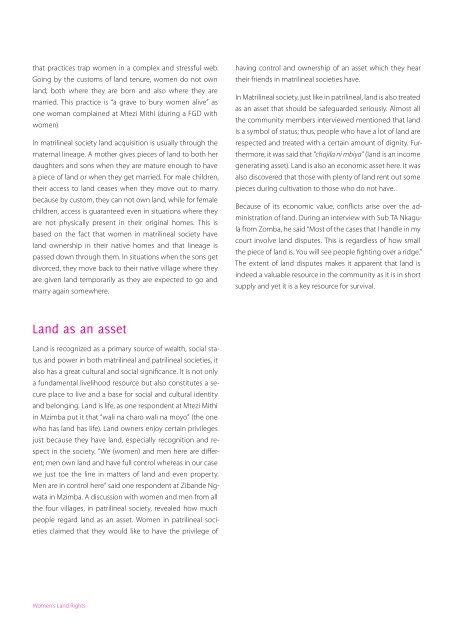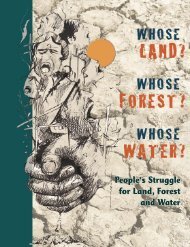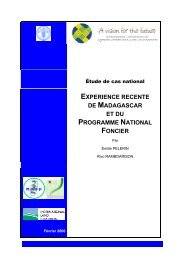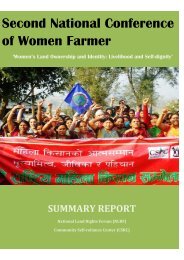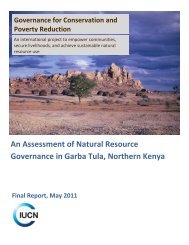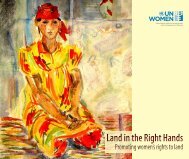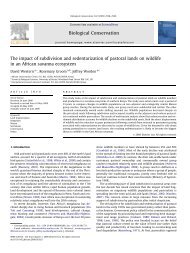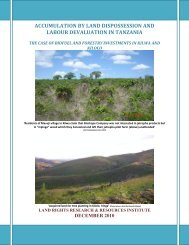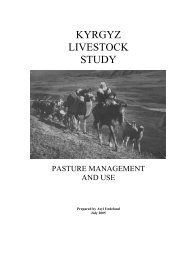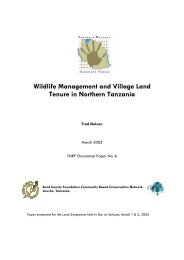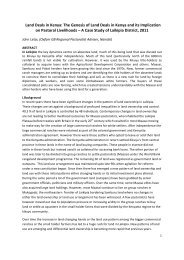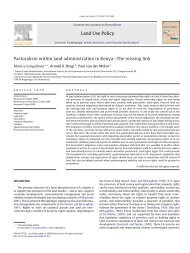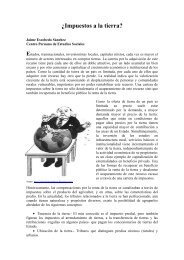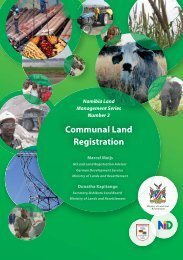Women's access to land and household bargaining power
Women's access to land and household bargaining power
Women's access to land and household bargaining power
You also want an ePaper? Increase the reach of your titles
YUMPU automatically turns print PDFs into web optimized ePapers that Google loves.
that practices trap women in a complex <strong>and</strong> stressful web.<br />
Going by the cus<strong>to</strong>ms of <strong>l<strong>and</strong></strong> tenure, women do not own<br />
<strong>l<strong>and</strong></strong>, both where they are born <strong>and</strong> also where they are<br />
married. This practice is “a grave <strong>to</strong> bury women alive” as<br />
one woman complained at Mtezi Mithi (during a FGD with<br />
women)<br />
In matrilineal society <strong>l<strong>and</strong></strong> acquisition is usually through the<br />
maternal lineage. A mother gives pieces of <strong>l<strong>and</strong></strong> <strong>to</strong> both her<br />
daughters <strong>and</strong> sons when they are mature enough <strong>to</strong> have<br />
a piece of <strong>l<strong>and</strong></strong> or when they get married. For male children,<br />
their <strong>access</strong> <strong>to</strong> <strong>l<strong>and</strong></strong> ceases when they move out <strong>to</strong> marry<br />
because by cus<strong>to</strong>m, they can not own <strong>l<strong>and</strong></strong>, while for female<br />
children, <strong>access</strong> is guaranteed even in situations where they<br />
are not physically present in their original homes. This is<br />
based on the fact that women in matrilineal society have<br />
<strong>l<strong>and</strong></strong> ownership in their native homes <strong>and</strong> that lineage is<br />
passed down through them. In situations when the sons get<br />
divorced, they move back <strong>to</strong> their native village where they<br />
are given <strong>l<strong>and</strong></strong> temporarily as they are expected <strong>to</strong> go <strong>and</strong><br />
marry again somewhere.<br />
L<strong>and</strong> as an asset<br />
L<strong>and</strong> is recognized as a primary source of wealth, social sta-<br />
tus <strong>and</strong> <strong>power</strong> in both matrilineal <strong>and</strong> patrilineal societies, it<br />
also has a great cultural <strong>and</strong> social significance. It is not only<br />
a fundamental livelihood resource but also constitutes a secure<br />
place <strong>to</strong> live <strong>and</strong> a base for social <strong>and</strong> cultural identity<br />
<strong>and</strong> belonging. L<strong>and</strong> is life, as one respondent at Mtezi Mithi<br />
in Mzimba put it that “wali na charo wali na moyo” (the one<br />
who has <strong>l<strong>and</strong></strong> has life). L<strong>and</strong> owners enjoy certain privileges<br />
just because they have <strong>l<strong>and</strong></strong>, especially recognition <strong>and</strong> respect<br />
in the society. “We (women) <strong>and</strong> men here are different;<br />
men own <strong>l<strong>and</strong></strong> <strong>and</strong> have full control whereas in our case<br />
we just <strong>to</strong>e the line in matters of <strong>l<strong>and</strong></strong> <strong>and</strong> even property.<br />
Men are in control here” said one respondent at Zib<strong>and</strong>e Ngwata<br />
in Mzimba. A discussion with women <strong>and</strong> men from all<br />
the four villages, in patrilineal society, revealed how much<br />
people regard <strong>l<strong>and</strong></strong> as an asset. Women in patrilineal societies<br />
claimed that they would like <strong>to</strong> have the privilege of<br />
Women’s L<strong>and</strong> Rights<br />
having control <strong>and</strong> ownership of an asset which they hear<br />
their friends in matrilineal societies have.<br />
In Matrilineal society, just like in patrilineal, <strong>l<strong>and</strong></strong> is also treated<br />
as an asset that should be safeguarded seriously. Almost all<br />
the community members interviewed mentioned that <strong>l<strong>and</strong></strong><br />
is a symbol of status; thus, people who have a lot of <strong>l<strong>and</strong></strong> are<br />
respected <strong>and</strong> treated with a certain amount of dignity. Furthermore,<br />
it was said that “chajila ni mbiya” (<strong>l<strong>and</strong></strong> is an income<br />
generating asset). L<strong>and</strong> is also an economic asset here. It was<br />
also discovered that those with plenty of <strong>l<strong>and</strong></strong> rent out some<br />
pieces during cultivation <strong>to</strong> those who do not have.<br />
Because of its economic value, conflicts arise over the administration<br />
of <strong>l<strong>and</strong></strong>. During an interview with Sub TA Nkagula<br />
from Zomba, he said “Most of the cases that I h<strong>and</strong>le in my<br />
court involve <strong>l<strong>and</strong></strong> disputes. This is regardless of how small<br />
the piece of <strong>l<strong>and</strong></strong> is. You will see people fighting over a ridge.”<br />
The extent of <strong>l<strong>and</strong></strong> disputes makes it apparent that <strong>l<strong>and</strong></strong> is<br />
indeed a valuable resource in the community as it is in short<br />
supply <strong>and</strong> yet it is a key resource for survival.


